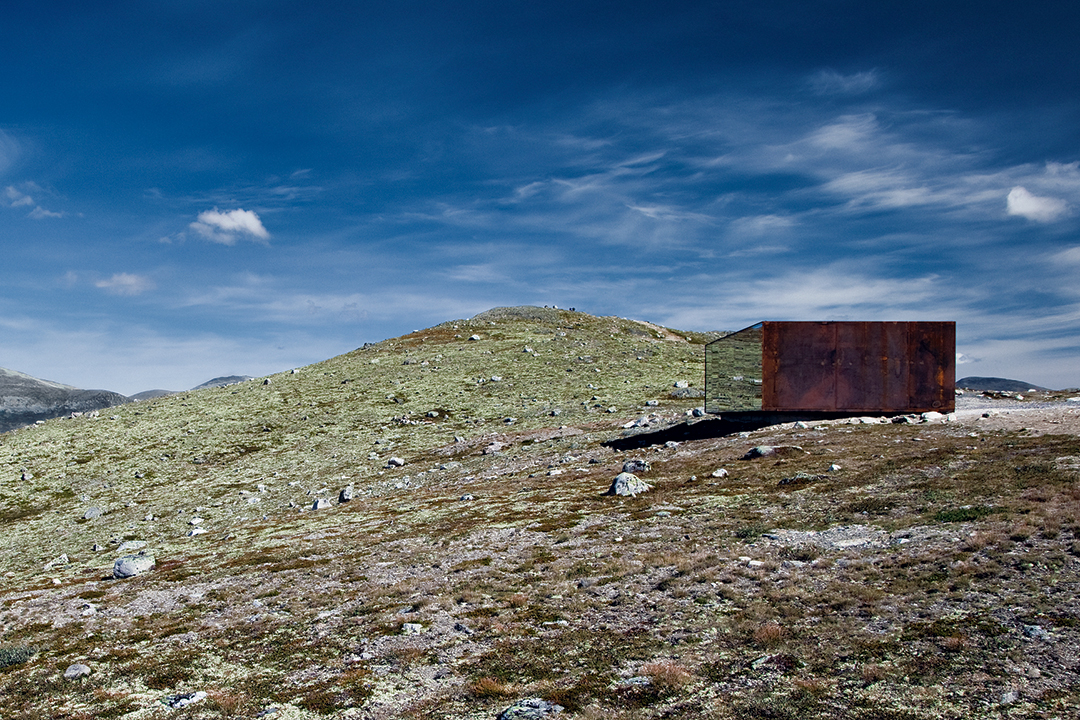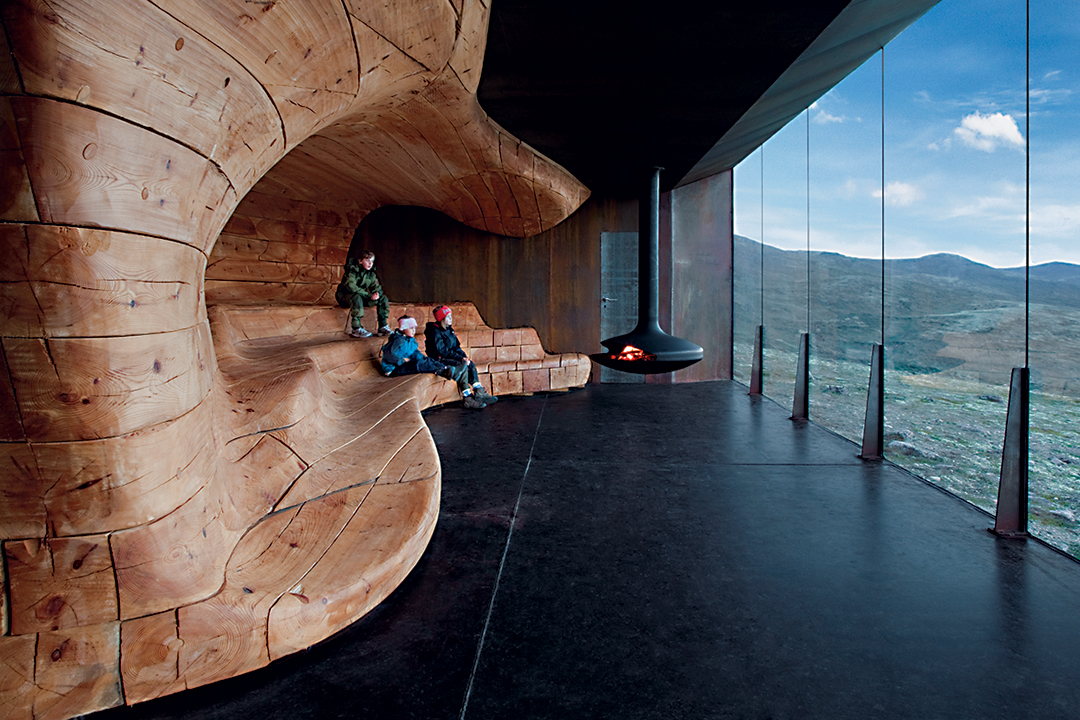Snøhetta is one of the world’s most recognized architectural practices. It is also the name of one of Norway’s highest mountains. Now you can enjoy the view of the majestic mountain from Snøhetta’s pavilion at Tverrfjellet Mountain, in the midst of Dovrefjell national park.
Getting there is worth the struggle. The landscape and the mountains are magnificent. After a short hike, you can say to yourself: Come in and sit down. Enjoy the magnificent view towards one of Norway’s most beautiful mountains. And enjoy the wonderful interior that folds itself around you. In all its simplicity, the Snøhetta pavilion offers an exceptional experience.
It might seem unlikely, but there is a resemblance between Snøhetta’s famous Opera house (2008) in Norway’s capital Oslo, and the little pavilion in the mountains outside the village of Hjerkinn. We are not speaking of size or architectural form, but when it comes to aesthetic expression and the relation between inner and outer architecture the two buildings have a lot in common.
Both buildings have a simple, or clean, outer form built upon a logical presentation of the building’s functions. When you enter the two buildings, the interior opens up like a Pandora’s Box, revealing beautifully detailed elements in a grand, but simple plan.
It might well be that the pavilion at Tverrfjellet will be as famous as the Oslo Opera house. The pavilion has already won its first prize. In November last year Snøhetta received the WAF Award in the category Display during the World Architecture Festival (WAF) in Barcelona.

The pavilion is built as a shelter for those who follow the trail up to the pass called Tverrfjellet. From this point you have a magnificent view of Snøhetta and the Dovrefjell area. The position opens up for a dramatic landscape: in front of you the terrain falls steeply to form a pot-shaped landscape that divides you from the mountain massif.
You can reach the pavilion after approximately 20 minutes of walking from a parking place close to the village of Hjerkinn, in the middle of southern Norway on the main route between Oslo and Trondheim. After the walk, you will discover that entering the pavilion is the clue to the adventure: when you reach the end of the trail, (it is accessible for wheelchairs), and arrive at the viewpoint, the cabin is blocking the view towards Snøhetta. The exterior wall with its organic shape invites you in, and it feels only natural to enter the pavilion. And at the moment you open the door and enter the box, the magnificent landscape opens up in front of you. That is truly a special experience. The weather was nice when I visited the pavilion, but I would guess that even when it is raining and the fog is drifting it will be a grand experience.
The beautiful view is not the only reason why you should take your time to hike up to the Tverrfjellet pavilion. Firstly, Snøhetta is the mountain that has given the architectural firm its name, and every year the firm’s employees are invited on a tour to climb to the top of the mountain. Secondly, the Dovrefjell area is a mountain massif of huge importance and heavy symbolic value in the history of Norway. When the Norwegians wrote their Constitution, gaining their independence after the Napoleonic wars in 1814, the participants ended the session stating ‘Agreeing and believing until Dovre falls’.
The reason for the Dovre Mountains’ symbolic value is their position in the middle of the southern part of Norway, in a geographical area that includes several of the country’s highest mountains. Traditionally Dovre was regarded as the central point of Norway. It has also been a training area for the Norwegian armed forces, and the clearance of a former shooting range in the pot-shaped landscape between the cabin at Tverrfjellet and Snøhetta is still in operation.

What makes the pavilion’s architecture special is the combination of a sharply shaped and simple outer form, and the elaborate interior. The exterior consists of a rust-treated, steel frame that defines the rectangular box. Inside the box the organically shaped, wooden interior is something in its own right. It is already presented on the outside, on the long wall that meets your eye when you arrive at the view-point. That is because the interior is made up entirely of massive, wooden logs that are shaped and added to form an organic ‘landscape’ of benches and walls that invite you to sit down, lean back and relax.
On the other side, facing the mountain massif around Snøhetta, the wall is made entirely of glass, from top to bottom. The view is magnificent from inside the building. And that is the whole point: The building presents you with a frame around the beautiful and dramatic view. In this way a connection is made to the long history of landscape painting, and Snøhetta’s modern architecture gives the tradition a new twist.
Another point is the contrast between the mechanically constructed steel frame and the handcrafted, wooden interior. The interior is made as one piece; it is expressive in its shape and organic in its form. It is a like a wave in motion, frozen as it hit the alien steel frame. And in order to contrast the impact of a winter storm, a fireplace hangs from the ceiling in the inner end of the room, as a sculpture in its own right.
It is when you meet contrasts like these that you might envision the significance of the conflict between nature and man-made culture. The Snøhetta pavilion visualizes the conflict, but it also builds a bridge across the gap. And it allows you to experience how valuable the meeting between modernist architecture and organically based handicrafts can be. Maybe Snøhetta’s Tverrfjellet pavilion points out a new way to envision, construct and build a new architecture that gives us the possibility to be whole, human beings?